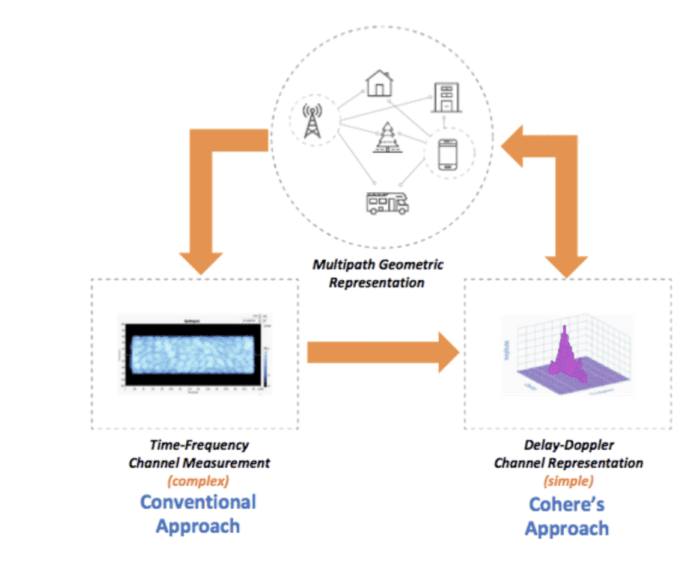The promise of Open RAN rests, in part, on the concept that through the virtualizing and disaggregation of Radio Access Network components and software, new players and best-of-breed solutions will emerge that otherwise wouldn’t get much oxygen in an atmosphere dominated by a handful of global network vendors.
Startup Cohere Technologies is betting that its software-based approach to increasing spectral efficiency will be one such solution. The company announced yesterday that the platform, which it claims can as much as double spectral efficiency, will be available in cloud form by the end of this year. Its Spectrum Multiplier platform can be integrated within the RAN in the Distributed Unit (DU), the Central Unit (CU), or as an xApp in the RAN Intelligent Controller (RIC) within a telco cloud or O-RAN system, without any changes to handsets, radios or antennas, according to the company.
Cohere Chairman and CEO Ray Dolan sees the company on a path that has previously been walked by companies like Flarion, which Dolan co-founded and which was acquired by Qualcomm in 2006 for $600 million, for its expertise in OFDMA and the invention of Flash-OFDM for mobile internet services; and by Qualcomm itself. Dolan had a front-row view on CDMA tech development from his director of technology role at NYNEX Mobile (a Verizon predecessor company) in the early ’90s; NYNEX was an early supporter of CDMA technology and its network contracts with Qualcomm helped drive and scale CDMA technology.
Dolan says that he is using his experience at those companies to inform how he is leading Cohere, and hoping for a similar path to success for the company’s technology. When he first joined the company in 2018, Dolan says he found a brilliant team and an Orthogonal Time Frequency Space solution that worked — but that found itself out in the cold because it wasn’t entirely cellular standards-based. A successful trial with Telefonica in 2018 “crushed everyone’s expectations,” Dolan says — but the carrier passed on further deployment because part of the solution wasn’t standards-compliant, according to Dolan. “The real takeaway was, it doesn’t matter how good you are, if you’re not part of the standards,” he said. So Cohere decided to move forward with the part of its solution that was 3GPP standards-compliant, and turn itself from a system supplier into a software company. “The good news is, there was plenty of power in this component by itself to improve 4G and 5G,” he added.
As Dolan describes it, Cohere’s Delay Doppler approach is an “alternative way to figure out, what is the channel path between the base station and you as a user, [and] what is the channel path between the base station and me as a user, when we’re both trying to get access to the same site and we’re both generally in the same vicinity?” If you know those paths and can predict them, Dolan explains, beam energy can be precisely directed to users in a way that substantially increases the site’s capacity. “The question is, can you keep them isolated [to avoid interference between beams serving each user] and can you track them while they’re moving? We do that extremely well,” he says.
Dr. Andrea Goldsmith, dean of Engineering at Princeton University and chair of Cohere’s Technical Advisory Board, said in a statement that Cohere’s “accurate dynamic channel representation over time and space enables predictive spatially multiplexed cloud-based scheduling, which significantly increases data rates and reliability of wireless networks.” And, according to Dolan, this is achieved with no change to the antenna, the radio or the handsets; it can work with any cellular standard and the company has proved it out in both 4G and 5G; and in any spectrum band.
If carriers want to implement Cohere’s solution, however, existing network suppliers would have to build it in to their products. Getting new network software accepted by major players such as Nokia or Ericsson is no small feat — which Dolan acknowledges. But the emerging Open RAN ecosystem offers another option, one which Cohere has embraced along with a standards-based approach; it is part of the Next G Alliance, the O-RAN Alliance, the Open RAN Policy Coalition and the Open Networking Foundation (ONF).
Cohere’s tech won a GSMA 2020 Global Mobile Award for best network software breakthrough; in February of last year, Deutsche Telekom announced that it was working with VMware and Intel on a cloud-based virtual RAN platform based on O-RAN standards, with Cohere and Mavenir as initial partners. A demonstration that month at DT’s Bonn headquarters leveraged Cohere’s technology in a set-up that included commercial 4G mobile devices connected to a standard 4T4R dual-polarized antenna and commercial radio; Cohere said that it “showed a 2x spectrum and capacity multiplier effect for 4G devices connected to the commercial spectrum, with no changes to the devices, radios or antennas.” The company has since worked to provide the same benefits in a 5G context.
“We have POCs going with a number of Tier 1s. All of them are very excited about the results to date,” Dolan said this week. “And what they’re asking is, ‘You guys keep doing this by yourselves, I’m going to go get you an ecosystem.'” This was the company’s plan: Build out the Spectrum Multiplier solution in a simple form, show it to the primary audience (carriers who could double the capacity of their spectrum holdings), demonstrate the efficacy, and ride a wave into network vendors with the weight of carrier desire behind them. In the meantime, taking its software into cloud-based form is part of the company’s effort to both demonstrate its ability to scale and diversify its potential customer base. After all, Dolan says, if intelligence is taken out of the base station and put into the cloud, that essentially leaves an access point on the tower and a bare-metal server on the site — and many companies might be interested in providing that server, if they had a partner who could provide the software.


